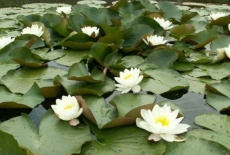30.01.2018 - Press release - World Wetland Day, 2. 2. 2018
Second day of February belongs to the wetlands. Apart form the traditional feast of Candlemas we also remind World Wetland Day. The fact that this day of wetlands is mentioned also in calendar is the proof how important they are for maintainig stability of Earth´s ecosystem. However the wetlands are still one of the most threatened habitats on Earth and there is still less and less of them.
The trend of wetland decrease prevails over the opposite trend - in spite of the effort of all conservationists and international agreements. This trend continues in spite of the fact that wetlands hide a lot of treasures that have not yet been revealed or appreaciated and even when we already know how importnat wetlands are in storing the water - they are like a sponge - in times of surplus they absorb the water, and in times of scarcity they release it into the environment. In spite of the fact that wetlands possess many irreplaceble functions for securing healthy Earth that are only starting to be recognized. In spite of the fact that wetlands hide the richest occurence of species among all of the habitats. In spite of the fact that we know there is no water without wetlands and there is no life for people and other organism without water. And still, the wetlands are diminishing.
Why is it so? Water in them become an undesirable factor on the places where a man wants to see buildings or agricultural development instead of the wetlands. They stay in a way of new roads or agriculture machines and that´s the reason for drying the land using melioration canals. Wetlands stay in a way of shipping - so the water dams or floating channels are built. Wetlands stay in a way when producing electricity - so they are destroyed in favour of building hydro power plants. Wetlands stay in a way of new shopping centres or housing - so the new barrier is built - flood barriers and dikes is constructed or they are drained and dryied. Every day we find many reasons why a certain wetland needs to give way to some "development". We don´t want to leave space for water and wetlands. However this could cost us a lot because in the end we may loose the water entirely.
Ramsar convention has been valid since 1975 and aims to conserve the most precious wetlands - 2241 of them are included in the convetion in the whole world. Regional Association for Nature Conservation and Sustainable Development tryies to conserve, restore and maintain in good condition at least some of them on the list - Danube floodplains, Šúr and Alluvium of the Rudava river. Without active intervention these wetlands wouldn´t have existed or they would have turned into slowly dying and drying or "stinking sewages"
To save the wetlands BROZ have realized more than 10 significant projects. Mainly thanks to the support from the European program LIFE the organisation managed to stop vanishing of these wetlands, to restore them and to continue further in activities focused on maintainig their stability - restoration of oxbow lakes of the Danube river, restoration of wet meadows, restoration of periodic lakes and shallow parts, restoration of river arms or floodplain forrests.
Till today BROZ has managed to restore the water flow and to revitalise 75 km of river arms and water streams and to restore 2404 ha of wetlands. Other activities that will help wetlands mainly in Danube floodplains continue within the frame of the project LIFE 14 NAT/SK/001306 Restoration and management of Danube floodplain habitats.
The project started with the motto: "We bring life to the heart of Danube floodplains" in 2015 and will last till the year 2022. It concentrates on the revitalisation of the Danube delta remnants - the former branch system in the floodplain area. Some of its ambicious aims to bring life to the floodplains are: to reconstruct 5 technical barriers (picture 2) on Danube river arms to ensure dynamic water regime with more water in them and by this to improve water regime in 1850 ha of wetlands in the river branch system, to restore water regime in the lenght of min. 4500 m of river arms, to restore connection of min. 2 isolated side arms with the Danube river and to restore 37 other wetlands in Danube floodplains. Other information about the project can be found on this web page: http://broz.sk/DunajskeLuhy/en


















